Rainwater Harvesting Ideal Source of Freshwater for Haiti
By Jose Pavero and others
In: Source Book of Alternative Technologies for Freshwater Augmentation in Latin America and the Caribbean
Rainwater harvesting is not used in Haiti, but over half a million people in the Caribbean get at least some of their water by this method. It is a possible solution for Haiti’s shortage of potable water and, together with this, the cholera epidemic. Rain-catchment systems are easy to build and operate and cost little to run. DC
Rainwater harvesting has been practiced for more than 4, 000 years, and, in most developing countries, is becoming essential.
Annual rainfall ranging from less than 50 to over 150 centimeters can be found in most Latin American countries and the Caribbean. Very frequently most of the rain falls during a few months of the year, with little or no precipitation during the remaining months.
For more than three centuries, rooftop catchments and cistern storage have been the basis of domestic water supply on many small islands in the Caribbean. Although the use of rooftop catchment systems has declined in some countries, it is estimated that more than 500,000 people in the Caribbean islands depend at least in part on such supplies.
Further, large areas of some countries in Central and South America, such as Honduras, Brazil, and Paraguay, use rainwater harvesting as an important source of water supply for domestic purposes, especially in rural areas.
Technical Description
A rainwater harvesting system consists of the three basic elements show in Figure 1:
1. A collection area. In most cases this is the roof of a house or a building. The effective roof area and the material used in constructing the roof influence the efficiency of collection and the water quality.
2. A conveyance system. This usually consists of gutters or pipes that deliver rainwater falling on the rooftop to cisterns or other storage vessels. Both drainpipes and roof surfaces should be constructed of chemically inert materials such as wood, plastic, aluminum, or fiberglass, in order to avoid adverse effects on water quality.
3. A storage system. The water ultimately is stored in a storage tank or cistern, which should also be constructed of an inert material. Reinforced concrete, fiberglass, or stainless steel are suitable materials. Storage tanks may be constructed as part of the building, or may be built as a separate unit located some distance away from the building.

Figure 1: Schematic of a Typical Rainwater Catchment System. Source: José Payero, Professor-Researcher, Department of Natural Resources, Higher Institute of Agriculture (ISA), Dominican Republic.
· All rainwater tank designs (see Figures 2A and 2B) should include as a minimum requirement:
- A solid secure cover;
- A coarse inlet filter;
- An overflow pipe;
- A manhole, sump, and drain to facilitate cleaning;
- An extraction system that does not contaminate the water, e.g., a tap or pump;
- A soakaway to prevent spilled water from forming puddles near the tank.
Additional features might include:
- A device to indicate the amount of water in the tank;
- A sediment trap, tipping bucket, or other “foul flush” mechanism;
- A lock on the tap;
- A second sub-surface tank to provide water for livestock, etc.

Figure 2A: Schematic of a Cistern. Source: Walter Santos, Center for Training in Agricultural Development, Bureau of Water Resources, Comayagua, Honduras.

Figure 2B: Schematic of a Storage Tank Reservoir. Source: Walter Santos, Center for Training in Agricultural Development, Bureau of Water Resources, Comayagua, Honduras.
Extent of Use
Rainwater harvesting is used extensively in Latin America and the Caribbean, mainly for domestic water supply and, in some cases, for agriculture and livestock supplies on a small scale.
In Brazil and Argentina, rainwater harvesting is used in semi-arid regions.
In Central American countries like Honduras, Costa Rica, Guatemala, and El Salvador, rainwater harvesting using rooftop catchments is used extensively in rural areas.
The Islas de la Bahía off the shores of Honduras meet a substantial portion of their potable water needs using rainwater from rooftop catchments. Similarly, rooftop catchments and cistern storage provide a significant water supply source for a small group of islands off the northern coast of Venezuela.
In a recent rural water-supply study, the continued use of rooftop and artificially constructed catchments was contemplated for those parts of rural Jamaica lacking access to river, spring, or well water sources. It is thought that more than 100 000 Jamaicans depend to a major extent on rainwater catchments.
Operation and Maintenance
Rainwater harvesting systems require few skills and little supervision to operate. Major concerns are the prevention of contamination of the tank during construction and while it is being replenished during a rainfall. Contamination of the water supply as a result of contact with certain materials can be avoided by the use of proper materials during construction of the system.
The main sources of external contamination are pollution from the air, bird and animal droppings, and insects.
Bacterial contamination may be minimized by keeping roof surfaces and drains clean but cannot be completely eliminated. If the water is to be used for drinking purposes, filtration and chlorination or disinfection by other means (e.g., boiling) is necessary.
The following maintenance guidelines should be considered in the operation of rainwater harvesting systems:
· A procedure for eliminating the “foul flush” after a long dry spell deserves particular attention. The first part of each rainfall should be diverted from the storage tank since this is most likely to contain undesirable materials which have accumulated on the roof and other surfaces between rainfalls. Generally, water captured during the first 10 minutes of rainfall during an event of average intensity is unfit for drinking purposes. The quantity of water lost by diverting this runoff is usually about 14 liters/square meter of catchment area.
· The storage tank should be checked and cleaned periodically. All tanks need cleaning; their designs should allow for this. Cleaning procedures consist of thorough scrubbing of the inner walls and floors. Use of a chlorine solution is recommended for cleaning, followed by thorough rinsing.
· Care should be taken to keep rainfall collection surfaces covered. This reduces the likelihood of frogs, lizards, mosquitoes, and other pests using the cistern as a breeding ground. Residents may prefer to take care to prevent such problems rather than have to take corrective actions, such as treating or removing water, at a later time.
· Chlorination of the cisterns or storage tanks is necessary if the water is to be used for drinking and domestic uses. The Montserrat Island Water Authority constructed a non-conventional chlorination device with a rubber tube, plywood, a 1.2 m piece of (polyvinylchloride) PVC tubing, and a hose clip to chlorinate the water using chlorine tablets.
· Gutters and downpipes need to be periodically inspected and cleaned carefully. Periodic maintenance must also be carried out on any pumps used to lift water to selected areas in the house or building. More often than not, maintenance is done only when equipment breaks down.
· Community systems require the creation of a community organization to maintain them effectively. Similarly, households must establish a maintenance routine that will be carried out by family members.
As has been noted, in some cases the rainwater is treated with chlorine tablets. However, in most places it is used without treatment. In such cases, residents are advised to boil the water before drinking. Where cistern users do not treat their water, the quality of the water may be assured through the installation of commercially available in-line charcoal filters or other water treatment devices.
Community catchments require additional protections, including:
· Fencing of the paved catchment to prevent the entry of animals, primarily livestock such as goats, cows, donkeys, and pigs, that can affect water quality.
· Cleaning the paved catchment of leaves and other vegetative matter.
· Repairing large cracks in the paved catchment as a result of soil movement, earthquakes, or exposure to the elements.
· Maintaining water quality at a level where health risks are minimized. In many systems, this involves chlorination of the supplies at frequent intervals.
Problems usually encountered in maintaining the system at an efficient level include the lack of availability of chemicals required for appropriate treatment and the lack of adequate funding.
Level of Involvement
The level of governmental participation varies in the countries of Latin America and the Caribbean. In some Caribbean islands, governments regulate the design of rainwater harvesting systems. Cisterns are likely to continue to be a principal source of water for residences in several Caribbean islands. Even if mandatory requirements are removed, their use will remain widespread, as they provide a water supply that residents consider to be safe, sufficient, and inexpensive.
Costs
The cost of this technology varies considerably depending on location, type of materials used, and degree of implementation.
In the U.S. Virgin Islands, costs as low as $2 to $5 per 1,000 liters are reported.
In Brazil, the cost of a 30-cubic meter cistern in rural areas of the Northeast is around $900 to $1,000, depending on the material used.
Construction costs for underground cisterns can vary tremendously, based on the size and the amount of excavation required. In Saint Lucia, the average cost of a 1, 500-liter plastic tank is $125.
Effectiveness of the Technology
Rainfall harvesting technology has proved to be very effective throughout several Latin American countries and most of the Caribbean islands, where cisterns are the principal source of water for residences. Cisterns are capable of providing a sufficient supply for most domestic applications.
The use of rainwater is very effective in lessening the demand on the public water supply system in the British Virgin Islands. It also provides a convenient buffer in times of emergency or shortfall in the public water supply. Also, because of the hilly or mountainous nature of the terrain in the majority of the British Virgin Islands, combined with dispersed housing patterns, rainfall harvesting appears to be the most practical way of providing a water supply to some residents. In many countries it is very costly, and in some cases not economically feasible, to extend the public water supply to all areas, where houses are isolated from one another or in mountainous areas.
Steep galvanized iron roofs have been found to be relatively efficient rainwater collectors, while flat concrete roofs, though highly valued as protection from hurricanes, are very inefficient. Rooftop catchment efficiencies range from 70% to 90%.
It has been estimated that 1 cm of rain on 100 square meters of roof yields 10,000 liters. More commonly, rooftop catchment yield is estimated to be 75% of actual rainfall on the catchment area, after accounting for losses due to evaporation during periods when short, light showers are interspersed with periods of prolonged sunshine. Likewise, at the other extreme, the roof gutters and downpipes generally cannot cope with rainfalls of high intensity, and excess water runs off the roof to waste during these periods.
Suitability
This technology is suitable for use in all areas as a means of augmenting the amount of water available. It is most useful in arid and semi-arid areas where other sources of water are scarce.
Advantages
· Rainwater harvesting provides a source of water at the point where it is needed. It is owner operated and managed.
· It provides an essential reserve in times of emergency and/or breakdown of public water supply systems, particularly during natural disasters.
· The construction of a rooftop rainwater catchment system is simple, and local people can easily be trained to build one, minimizing its cost.
· The technology is flexible. The systems can be built to meet almost any requirements. Poor households can start with a single small tank and add more when they can afford them.
· It can improve the engineering of building foundations when cisterns are built as part of the substructure of the buildings, as in the case of mandatory cisterns.
· The physical and chemical properties of rainwater may be superior to those of groundwater or surface waters that may have been subjected to pollution, sometimes from unknown sources.
· Running costs are low.
· Construction, operation, and maintenance are not labor-intensive.
Disadvantages
· The success of rainfall harvesting depends upon the frequency and amount of rainfall; therefore, it is not a dependable water source in times of dry weather or prolonged drought.
· Low storage capacities will limit rainwater harvesting so that the system may not be able to provide water in a low rainfall period. Increased storage capacities add to construction and operating costs and may make the technology economically unfeasible, unless it is subsidized by government.
· Leakage from cisterns can cause the deterioration of load bearing slopes.
· Cisterns and storage tanks can be unsafe for small children if proper access protection is not provided.
· Possible contamination of water may result from animal wastes and vegetable matter.
· Where treatment of the water prior to potable use is infrequent, due to a lack of adequate resources or knowledge, health risks may result; further, cisterns can be a breeding ground for mosquitoes.
· Rainfall harvesting systems increase construction costs and may have an adverse effect on home ownership. Systems may add 30% to 40% to the cost of a building.
· Rainfall harvesting systems may reduce revenues to public utilities.
Cultural Acceptability
In Latin America and the Caribbean, it has been found that projects which involved the local community from the outset in the planning, implementation, and maintenance have the best chance of enduring and expanding.
In the Caribbean, attitudes toward the use of rainwater for domestic consumption differ.
Some people, who depend on rainwater as their only source of supply, use it for all household purposes, from drinking and cooking to washing and other domestic uses.
Other people, who have access to both rainwater and a public water supply, use rainwater selectively, for drinking or gardening or flushing toilets, and use the public water supply for other purposes.
These varying attitudes are related to the level of education of the users as well as to their traditional preferences. Different sectors of the society need to be informed about the advantages of harvesting rainwater and the related safety aspects of its use, including the threat of mosquito problems and other public health concerns.
Information Sources and Contacts
Eduardo Torres, Investigador, Instituto Argentino de Investigaciones de las Zonas Aridas (IADISA), Bajada del Cerro de la Gloria s/n, Parque General San Martín, Casilla de Correo 507, 5500 Mendoza, Argentina. Tel. (54-1) 28-7995. Fax (54-1) 28-7995. E-mail: ntcricyt@criba.edu.ar.
Luiza Teixeira de Lima Brito, Pesquisadora, EMBRAPA/CPATSA, BR-428 km 152, Zona Rural, Caixa Postal 2356, 300-000 Petrolina, Pernambuco, Brasil. Tel. (55-81) 862-1711. Fax (55-81) 862-1744. E-mail: Luizatlb@cpatsa.embrapa.br.
Jorge Faustino Marco, Líder, Proyecto RENARAN/Cuencas, Centro Agronómico Tropical de Investigación y Enseñanza (CATIE), Apartado 7170, Turrialba, Costa Rica. Tel. (506) 556-6279/556-7830. Fax (506) 556-1576/556-1533. E-mail: jfaustin@catie.ac.cr.
Luis Alfredo Ochoa, Ingeniero, Instituto Nacional de Sismología, Vulcanología, Meteorología e Hidrología (INSIVUMEH), Ministerio de Comunicaciones, Transporte y Obras Públicas, 7a Avenida 14-17, Zona 13, Guatemala. Tel. (502-2) 31-4967/31-9163. Fax (502-2) 31-5005.
Ernesto Bondy Reyes, Director General, Dirección General de Recursos Hídricos (DGRH), Ministerio de Recursos Naturales, 100 metros al sur Campo Birichiche, Tegucigalpa, Honduras. Tel. (504) 32-6250/32-1386. Fax (504) 32-1828.
Eugenio Godoy Valdovinos, Comisión Nacional de Desarrollo Regional Integrado del Chaco Paraguayo, Dirección de Recursos Hídricos, Casilla de Correo 984/273, Filadelfia, Paraguay. Tel. (595) 91-275. Fax (595) 91-493.
Milagros Martínez Esquea, Ingeniero Agrónomo, Instituto Nacional de Recursos Hidráulicos (INDRH), Programa de Manejo de Agua a Nivel de Finca, Av. Jiménez Moya, Centro de los Héroes, Apartado Postal 1407, Santo Domingo, República Dominicana. Tel. (809) 533-5804/532-4863. Fax (809) 532-5889.
José Payero, Profesor-Investigador, Departamento de Recursos Naturales, Instituto Superior de Agricultura (ISA), Apartado 166, La Herradura, Santiago, República Dominicana. Tel. (809) 247-0082/247-2000. Fax (809) 247-2626/247-0085
Bwalya John Mwansa, Project Manager, Barbados Water Resources Management & Water Loss Studies, Barbados Water Authority, “Invermark”, Hastings, Christ Church, Barbados. Tel. (809) 430-9373. Fax (809) 430-9374.
Felipe Cisneros Espinosa, Profesor-Investigador, Instituto de Investigaciones de Ciencias Técnicas (IICT), Facultad de Ingeniería, Universidad de Cuenca, Av. 12 de abril s/n, Cuenca, Ecuador. Tel. (593-7) 831-688/819-891. Fax (593-7) 832-183. E-mail: fcisnero@az.pro.ec.
Bernardine Georges, Chef, Section Hidrologie, Service National des Ressources en Eaux, Ministère de 1′ Agriculture, des Ressources Naturelles et du Développement Rural, Av. Lamartinière 56, Port-au-Prince, Haiti. Tel. (509) 22-4057/45-4113. Fax (509) 22-3591.
Johannes Wrann, Ingeniero Forestal, Instituto Forestal (INFOR), Calle Huérfanos 554, Casilla de Correo 3085, Santiago, Chile. (56-2) 639-6189. Fax (56-2) 638-1286.
Margaret Dyer-Howe, General Manager, Montserrat Water Authority, Post Office Box 324, Church Road, Plymouth, Montserrat, BWI. Tel. (809) 491-8440. Fax (809) 491-4904.
Martha Pinedo-Medina, Coordinator, Water and Soil Section, Department of Agriculture, Animal Husbandry and Fisheries, Klein Kwartier N. 33, Curaçao, Netherlands Antilles. Tel. (599-9) 37-6170. Fax (599-9) 37-0723.
Martin Satney, Senior Agricultural Engineer, Ministry of Agriculture, Lands., Fisheries and Forestry, NIS Building, 5th Floor, Castries, Saint Lucia. Tel. (809) 450-2337. Fax (809) 453-6314.
Vincent Sweeney, Sanitary Engineer, Caribbean Environment and Health Institute (CEHI), Post Office Box 1111, The Home, Castries, Saint Lucia. Tel. (809) 452-1412. Fax (809) 453-2721. E-mail: cehi@isis.org.lc.
Moekiran Amatali, Director, Hydraulic Research Division, Magnesium Street 41 (Duisburglaan), Post Office Box 2110, Paramaribo, Suriname. Tel. (59-7) 49-0963. Fax (59-7) 46-4901/49-0627.
Joseph E. Williams, Chief Environmental Health Officer, Environmental Health Department, Ministry of Health and Social Security, Duncombe Alley, Grand Turk, Turks and Caicos Islands, BWI. Tel. (809) 946-2152/946-1335. Fax (809) 946-2411.
Henry H. Smith, Director, Water Resources Research Institute, University of the Virgin Islands, #2 John Brewers Bay, St. Thomas, U.S. Virgin Islands 00802-9990. Tel. (809) 693-1063. Fax (809) 693-1074. E-mail: hsmith@uvi.edu.
Basil Fernandez, Managing Director, Water Resources Authority, Hope Gardens, Post Office Box 91, Kingston 7, Jamaica. Tel. (809) 927-1878. Fax (809) 977-0179.
Bibliography
Barbados Water Authority. Sub-Committee on Water Resources. 1984. Report on Supply-Use of Roof and Parking Lot Catchments. Christ Church.
Bernat, C., R. Courcier, and E.A. Sabourin. 1993. Cisterna de Placas, Técnicas de Construção. Recife, Massagano.
Economic and Social Commission for Asia and the Pacific (ESCAP). 1989. “Rainwater Harvesting Techniques and Prospects for their Application in Developing Island Countries.” In Water Resources Development in Asia and the Pacific: Dam Safety Evaluation and Monitoring, Water Tariffs and Rainwater Harvesting. Bangkok. pp. 101-108. (United Nations Water Resources Series No. 63)
Edwards, D., and K. Keller. 1984. A Workshop Design for Rainwater Roof Catchment Systems (Training Guide) and Appendix: Rainwater Harvesting for Domestic Water Supplies in Developing Countries. La Paz, UNESCO/ROSTLAC, UNICEF, Instituto de Hidráulica e Hidrología.
EMBRAPA-CPATSA. n.d. Captación y Conservación de Agua de Lluvia para Consumo Humano. Petrolina, PE, Brazil. (Circular Técnica No. 12)
Gonguez, P. 1980. “Water Supplies in Off-shore Islands and Coastal Communities.” Paper presented at the United Nations/Commonwealth Science Council (CSC) Seminar on Small Island Water Problems, Barbados.
Gould, J.E. 1990. “Development of Rainwater Catchment Systems: Technology and Implementation Strategies in the 1980’s and Lessons for the 1990’s.” In: Experiences in the Development of Small-Scale Water Resources in Rural Areas: Proceedings of the International Symposium on Development of Small-Scale Water Resources in Rural Areas, Bangkok, Carl Duisberg Gesellsehaft, South East Asia Program Office, pp. 95-105.
Hadwen, P. 1987. “Caribbean Islands: A Review of Roof and Purpose Built Catchments.” In Non-Conventional Water Resources Use in Developing Countries. New York, United Nations, pp. 455-468. (Natural Resources/Water Series No. 22).
——, (ed.). 1980. Proceedings of the United Nations Seminar on Small Island Water Problems. Bridgetown, UNDP.
——, and de A. Jong. 1984. Improvement of Water Supplies in St. Vincent Grenadines. Kingstown, UNDP Project RLA/82/023. (Informal Report 17)
Haebler, R.H., and D.H. Waller. 1987. “Water Quality of Rain Water Collection Systems in the Eastern Caribbean.” In Proceedings of the Third International Conference on Rainwater Cistern Systems. Khon Kaen, Thailand, Khon Kaen University.
Heggen, RJ. 1984. “Rainwater Catchment Systems: A Review.” In Proceedings of the Second International Conference on Rainwater Cistern Systems (H.H. Smithe, ed.). St. Thomas, U.S.V.I., Caribbean Research Institute and Virgin Islands Branch, ASCE, pp. A3.1-A1-13.
Janssens, L. 1978. Preliminary Assessment of Rainwater Catchment Possibilities at Nassau International Airport. Nassau, UNDP. (Project BHA/73/004, Technical Report 3)
Junker, M. 1995. Abastecimiento de Agua Potable en los Asentamientos Indígenas de Diez Leguas. Filadelfia, Paraguay. Dirección de Recursos Hídricos de Paraguay e Instituto Federal de Geociencias y Recursos Naturales de Alemania. (Cooperación Hidrogeológica Paraguayo-Alemana, Informe Técnico N°1)
Keller, S. 1995. Posibilidades de Desarrollo del Chaco Paraguayo por el Control del Consume de Agua Subterránea y el Aprovechamiento de las Precipitaciones. Filadelfia, Paraguay/Hannover, Alemania. Dirección de Recursos Hídricos de Paraguay e Instituto Federal de Geociencias y Recursos Naturales de Alemania. (Cooperación Hidrogeológica Paraguayo-Alemana, Informe Técnico N° 14)
Leung, Ping-Sun, and Yu-Si Fok. 1982. “Determining the Desirable Storage Volume of a Rainwater Cistern System: A Stochastic Assessment.” In Proceedings of the First International Conference on Rainwater Cistern Systems. Honolulu, University of Hawaii, Water Resources Center, pp. 233-244.
Lorenzo, Nieves. 1988. Proyecto de Presupuesto para la Construcción de Cisternas Rurales en los Caseríos Corozalito y el Guanábano del Distrito Zamora Estado Flacón. Coro, Venezuela, FUDECO-PIDZAR.
MARAVEN. Gerencia de Relaciones Publicas, Gerencia de la Faja Petrolífera del Orinoco. 1987. Tecnologia Alterna Cosechando la Lluvia. Maracaibo, Venezuela.
Myers, L.E. 1974. “Water Harvesting, 2000 BC to 1974 AD.” In Proceedings of the Water Harvesting Symposium. Phoenix, Arizona, U.S. Department of Agriculture. (Report No. ARS-W. 22, 1-7)
——, 1967. “Recent Advances in Water Harvesting.” Journal of Soil and Water Conservation, 22(3), pp. 95-97.
Nova Scotia Department of Health, n.d. The Use of Rainwater for Domestic Purposes in Nova Scotia. Halifax, N.S., Canada.
Oliveira, A.M., and J.V. Martinez. 1987. Tecnologías Simples para Aproveitamentos de Pequeno Porte dos Recursos Hídricos do Semi-Árido Nordestino. Rio de Janeiro, Associação Brasileira de Geologia de Engenharia. (Artigo Técnico 14)
Oosterbaan, A.W.A. and J.Z. Martinez. 1987. “Cisternas Rurales Tipo CPATSA. Un Manual para su Dimensionamiento, Construcción y Mantenimiento en el Chaco Central, Paraguay.” Filadelfia, Paraguay. PNUD Proyecto PAR/86/003. (Unpublished)
Penn, Gary. 1986. The Present State of Water Supply in the British Virgin Islands. Paper presented by the Chief Engineer of the Water and Sewerage Department at the Fifteenth Caribbean Water Engineers Conference, Tortola, 25-28 November.
Pescatore, Italia, and Nieves Lorenzo. 1987. Captación y Conservación de Agua de Lluvia para Consume Humano: Cisternas Rurales, Dimensionamiento, Construcción y Manejo. Barquisimeto, Venezuela, FUDECO-PIDZAR.
Pérez Hernández, David. 1994. Aprovechamiento del Embalse San Francisco y Otras Fuentes Alternas de Agua en Macanao, Estado Nueva Esparto. Caracas, MARNR.
Proceedings of the First International Conference on Rainwater Cistern Systems. 1982. Honolulu, Hawaii, University of Hawaii, Water Resources Research Center.
Proceedings of the Second International Conference on Rainwater Cistern Systems. (H.H. Smith, ed.). 1984. St. Thomas, U.S.V.I., Caribbean Research Institute and Virgin Islands Branch, ASCE.
Proceedings of the Third International Conference on Rainwater Cistern Systems. 1987. Khon Kaen, Thailand, Khon Kaen University.
Proceedings of the Fourth International Conference on Rainwater Cistern Systems. 1989. Manila, International Development Research Centre, Canadian International Development Agency, and Philipine Water Works Association.
Reller, R. 1982. Rainwater Harvesting for Domestic Water Supplies in Developing Countries. Washington, D.C., USAID. (Water and Sanitation for Health Project, Working Paper No. 20)
Rinehart, F. 1983. Water Quality of Cistern Water in St. Thomas, United States Virgin Islands. #1 John Brewers Bay, St. Thomas, College of the Virgin Islands, Caribbean Research Institute. (Technical Report No. 15)
Ruskin, R., et al. 1988. Maintenance of Cistern Water Quality in the Virgin Islands. #2 John Breyers Bay, St. Thomas, University of the Virgin Islands, Water Resources Research Institute. (Technical Report No. 30)
Santos, Walter W. 1992. Cosechas de Aguas de Lluvias Para Uso Domestico. Comayagua, Honduras, Centro de Entrenamiento de Desarrollo Agrícola, Dirección de Recursos Hídricos.
Schiller, E.J. and B.G. Latham. n.d. Sistemas de Captación de Aguas Pluviales. Santiago, Chile, OPS/CEPIS.
Silva, A. de Souza, and E. Rocha Porto. 1982. Utilização e Conservação dos Recursos Hídricos en Areas Rurais do Trópico Semi-árido do Brasil. Petrolina, PE, Brazil, EMBRAPA-CPATSA. (Documento No. 14)
—–, et al. 1984. Cisternas Rurais. Dimensionamento, Construção e Manejo. Petrolina, PE, Brazil, EMBRAPA-CPATSA-SUDENE. (Circular Técnica No. 12)
—–, et al. 1988 Captação e Conservação de Água de Chuva no Semi-árido Brasileiro: Cisternas Rurais. II. Agua para Consume Humano. Petrolina, PE, Brazil, EMBRAPA-CPATSA. (Circular Técnica No. 16)
Smith, Henry H. 1983. Effects of Various Factors on the Sizing of Rain Water Cistern Systems. #2 John Brewers Bay, St Thomas, College of the Virgin Islands, Caribbean Research Institute. (Technical Report No. 19)
Thomas, E.N. 1980. “The Artificial and Roof Rainwater Catches of Bermuda.” Paper presented at the UN/CSC Seminar on Small Islands Water Problems. Barbados.
United Nations. Department of Technical Cooperation and Development. 1989. Roof Catchments, Roof Coverings, Guttering and Downpipes. New York. (United Nations Water Resources Assessment and Planning in Pacific Islands; UNDP Project RAS/87/009)
UNEP. 1983. Rain and Stormwater Harvesting in Rural Areas. Nairobi, pp. 92-113. (Water Resources Series, 5)
Waller, D.H. 1982. “Rainwater as a Water Supply Source in Bermuda.” In Proceedings of the First International Conference on Rain Water Cistern Systems. Honolulu, University of Hawaii, Water Resources Research Center, pp. 184-193.
Sources: Source Book of Alternative Technologies for Freshwater Augmentation in Latin America and the Caribbean | Sunday Gleaner (photos)

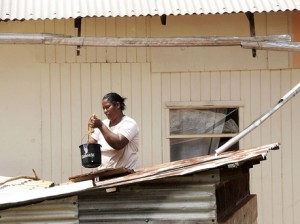
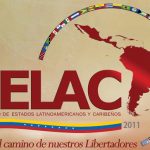
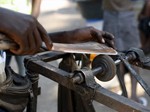
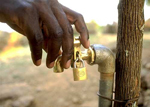
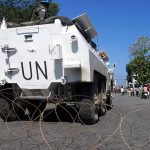


Comments
Rainwater Harvesting Ideal Source of Freshwater for Haiti — No Comments